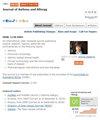What is the Best Way to Diagnose Possible Asthma Patients with Negative Bronchodilator Reversibility Tests?
IF 3.7
3区 医学
Q2 ALLERGY
引用次数: 0
Abstract
Objective: The best method and strategy for the diagnosis of asthma remains unclear, especially in patients with negative bronchodilator reversibility test (BDRT). In our study, we aimed to investigate the diagnostic yield of peak expiratory flow (PEF) variability for this patient group.Methods: A total of 50 patients with suspected asthma, all with negative BDR test, were included in the study. Demographic information and symptoms were recorded and PEF variability was monitored for 2 weeks. Metacolinbronchial provocation test (mBPT) was performed. Asthma was diagnosed when PEF variability ≥ 20% and/or positive mBPT was observed.
Results: 30 of 50 patients were diagnosed with asthma. After 1 month, 17 patients were evaluated for treatment outcomes. The sensitivity and specificity of PEF variability for different cut-off values (≥ 20%, > 15% and > 10%) were 61.5– 83.3, 88.5– 62.5 and 100– 16.7, respectively. One of the most important findings of our study was the absence of variable airflow limitation or airway hyper reactivity in 39% patients with a previous diagnosis of asthma. Multiple logistic regression analysis revealed that a low baseline FEF25-75 value was an independent predictive factor for the diagnosis of asthma (p= 0.05).
Conclusion: The most efficient diagnostic test for asthma is still unclear due to many factors. Our study is one of the few studies on this subject. Although current diagnostic recommendations generally recommend a PEF variability of 10% for the diagnosis of asthma, this threshold may not be appropriate for the BDR-negative patient group. Our results suggest using a threshold value of < 15% for PEF variability when excluding asthma and ≥ 20% when confirming the diagnosis of asthma in patients with clinically suspected but unproven reversibility. Furthermore, FEF25-75 is considered to be an important diagnostic parameter that should be included in diagnostic recommendations for asthma.
Keywords: diagnosis of asthma, reversibility, peak expiratory flow (PEF) variability, bronchial challenge test, forced expiratory flow (25-75%)
支气管扩张剂可逆性试验阴性的哮喘患者的最佳诊断方法是什么?
目的:诊断哮喘的最佳方法和策略仍不明确,尤其是支气管扩张剂可逆性试验(BDRT)阴性的患者。在我们的研究中,我们旨在调查呼气峰流速(PEF)变异性对这一患者群体的诊断效果:研究共纳入 50 名疑似哮喘患者,所有患者的 BDR 试验均为阴性。研究记录了患者的人口统计学信息和症状,并对患者的呼气流量变异性进行了为期两周的监测。进行间甲胆碱支气管激发试验(mBPT)。当观察到 PEF 变异性≥20% 和/或 mBPT 阳性时,即可诊断为哮喘:结果:50 名患者中有 30 名被诊断为哮喘。1 个月后,对 17 名患者进行了治疗效果评估。不同截断值(≥ 20%、> 15%和> 10%)下 PEF 变异性的敏感性和特异性分别为 61.5- 83.3、88.5- 62.5 和 100- 16.7。我们研究中最重要的发现之一是,39% 曾被诊断为哮喘的患者没有可变气流受限或气道高反应性。多元逻辑回归分析表明,FEF25-75 的基线值较低是哮喘诊断的一个独立预测因素(P= 0.05):结论:由于多种因素的影响,哮喘最有效的诊断测试尚不明确。我们的研究是这方面为数不多的研究之一。尽管目前的诊断建议通常推荐哮喘诊断的 PEF 变异率为 10%,但这一临界值可能并不适合 BDR 阴性的患者群体。我们的研究结果表明,在排除哮喘时,PEF 变异性的阈值应为 <15%,而在确诊临床疑似哮喘但未证实可逆性的患者时,PEF 变异性的阈值应≥20%。此外,FEF25-75 被认为是一个重要的诊断参数,应纳入哮喘的诊断建议中。关键词:哮喘诊断、可逆性、呼气峰流速(PEF)变异性、支气管挑战试验、用力呼气流速(25-75)
本文章由计算机程序翻译,如有差异,请以英文原文为准。
求助全文
约1分钟内获得全文
求助全文
来源期刊

Journal of Asthma and Allergy
Medicine-Immunology and Allergy
CiteScore
5.30
自引率
6.20%
发文量
185
审稿时长
16 weeks
期刊介绍:
An international, peer-reviewed journal publishing original research, reports, editorials and commentaries on the following topics: Asthma; Pulmonary physiology; Asthma related clinical health; Clinical immunology and the immunological basis of disease; Pharmacological interventions and new therapies.
Although the main focus of the journal will be to publish research and clinical results in humans, preclinical, animal and in vitro studies will be published where they shed light on disease processes and potential new therapies.
 求助内容:
求助内容: 应助结果提醒方式:
应助结果提醒方式:


